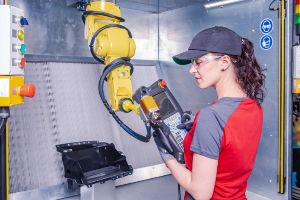How to Design a Custom Automation Cell

Adding a custom automation cell to your manufacturing line will increase efficiency, production, and profits. Work cells, also referred to as robot cells, are specialized to fulfill manufacturing needs. As you begin the process of designing your automated cell, use the following tips.
A Guide to Designing an Automation Cell
1. Consider Its Function
Before any decisions are made, figure out what roles the automation cell will fulfill. Custom automation cells can be designed to carry out just about any manufacturing purpose. What problems does it need to solve, and what type of work does it need to do? For example, handling hazardous chemicals can be dangerous for workers. An automated cell can take over this task to prevent human exposure and improve the safety and efficiency of the workplace.
Because the work cell will essentially do what workers are currently doing, you’ll need to map out the tasks in detail to ensure the production process is correct. Define the necessary inputs and outputs for your system, such as sensors or specific movements in response to outside information.
2. Determine the Requirements

To design the best custom automation cell for your purposes, outline your requirements. This process should account for factors such as precision, desired cycle time, the reach of the robotic arm, the specific End of Arm Tooling (EOAT), utilities necessary to run the work cell, and payload, which includes the EOAT. These requirements generally take some time and deliberation to finalize.
3. Devise a Layout
The placement of the robot and organization of the space within the cell must provide ample room for it to complete tasks quickly and efficiently, whether that includes swiveling, turning, or linear movements. Consider the safety of humans inside the cell as well. Many automation cells require people to work alongside the robot, so they may need barriers or barricades to protect workers from unsafe parts or applications. If there are large moving parts, the space should be big enough to safely accommodate the movement and your employees. Layouts should also map the base and all parts of the cell, including inputs and outputs.
Pacific Integrated Manufacturing in Bonita, CA, produces custom automation cells specified to your medical device manufacturing needs. Their automation solutions are precise, reliable, and efficient, allowing you to cut production costs while handling delicate and sensitive materials with care. Learn more about their custom automation cells online, or call the manufacturing company at (619) 921-3464 to receive a free quote.
About the Business
Have a question? Ask the experts!
Send your question

